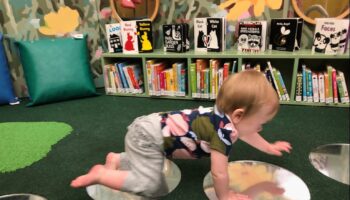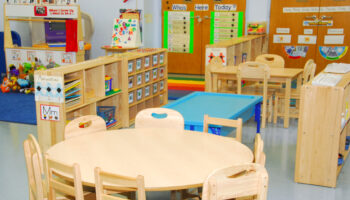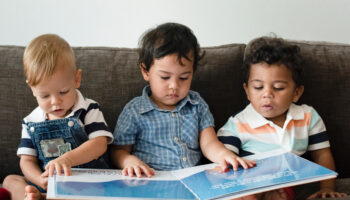Pam Schaffner
When we consider the word “environment” for preschool-age children we often think of learning centers and thus areas for concept development such as math, science, or art. We think of these learning centers in an elementary school setting as the subjects of the classes they have art class or math class.
The term environment is broader, and it should not be reduced to academic subjects alone. According to Meriam Webster, environment means: the conditions that surround someone or something: the conditions and influences that affect the growth, health, progress, etc., of someone or something.
To design an infant or toddler environment, let’s consider some basic needs of children or things that would influence the growth, health, and progress of a child. There is a need for the protection of health and safety, relationship building, and learning through hands-on experiences. A good infant or toddler classroom will promote all these things.
Infant and toddler spaces need to be safe and promote good health. No space can be made 100% safe. A child can fall on flat ground, but eliminating risk is paramount to such an environment. Cushioning under climbing equipment, covered electrical outlets, keeping chemicals locked away, and ensuring toys are safe for their age will not only protect their safety but will promote exploration. The child will hear “no” less frequently and be inspired to explore. Surfaces are kept clean and nearby sinks for hand washing will lessen illness. Children cannot come to school and be inspired to learn in their environment if they are home sick.
Children also need positive relationships with their teachers. Low ratios promote greater access to a teacher for care; but it is not just about a ratio. The environment can promote such relationships or hinder them. Providing softness and comfort will encourage teachers to spend more time on a child’s level because they can sit on the floor with greater ease. Spaces should not be crowded thus preventing a teacher from getting on a child’s level. Relationships thrive when there is communication. The classroom should have many toys and materials that teachers use with the children in play.
In setting up the environment it is also important to consider children forming relationships with one another, peer to peer. Infants and young toddlers prefer solitary or parallel play and do not often share in an experience with others. Thus, it is vitally important that toys in the classroom are ample and there are many duplicate toys, so sharing is needed less often. This will lessen behavioral challenges between children and promote relationship building. The environment should also promote interactions by having open spaces for play where children can play next to one another. Restrictive devices such as swings and seats should be used infrequently because they do not promote socialization or relationship forming, not to mention they inhibit exploration and learning.
Children also need hands-on experiences for learning. All is new for a young child; and all things must be explored with as many of the five senses as possible. If you have seen the “Willy Wonka and the Chocolate Factory” movie you can understand through the eyes of a young child, the need to explore. In that movie there was a scene where the children and their parents were taken into a room that was entirely edible. They scurried about tasting everything; it was a whole new world for them. When we are born, the world before us is just as new. Young children must touch things and taste things to know what is food and what isn’t. They need to explore using their five senses to make sense of every object they touch. Imagine at some point in your past not knowing if a bathtub was edible or not. We might think that is silly, however, at one point we tested that theory. Infants and toddlers need to experience things. It is why they are so busy and constantly moving.
Inspiring infant and toddler environments promote the use of the five senses:
- Tasting, one of the strongest of the five, is used a lot by children of this age. Sanitizing toys is important for the health of children but forbidding any exploration using the sense of taste is not recommended until a child is older. Once a child is done tasting a toy (exploring with their mouth), only then remove the toy from circulation.
- Touching is encouraged as well in inspiring environments. It is why there are so many textured toys and books on the market. Children need to feel soft, hard, smooth, bumpy, rough, etc. Safe toys should be provided that provide a variety of textures for the children to explore. Some non-toy textures can also be included if they are safe such as a basket with various fabrics in it.
- Hearing is vital to development as well. In fact, children can recognize voices while still in utero. It is important to carefully select sounds in a classroom because they can quickly become overwhelming. Playful songs if played all day can stress children out. Try a variety: nature music, children’s songs, and no music at times. Hearing conversations with no background sound is great too. Children love musical toys and instruments. If these are safe, include them as well. Non-musical toys and objects also make sounds. Demonstrate for children that paper makes noise when crumpled, chairs make sounds when moved, and food they eat makes sounds when broken or chewed.
- The sense of sight or seeing things is important. Inspiring environments are not too plain but also not over stimulating visually. Infants and toddlers are processing a lot of data coming in from their experiences. What they see (toys, display, people, etc.) are all contributing to what they know about the world. A cozy home-like environment visually will contribute to an inspiring environment.
- The sense of smell is often neglected. Children are taking in smells all around them as they play and eat, etc. It is important to point out smells as they are noticed. Smells can be added to the environment if they are safe and not overpowering. For example, bring in flowers or spend time taking in the smells of the outdoors.
A classroom that is safe and healthy and promotes exploration (with very few hinderances or “no’s”) will promote the development of infants and toddlers. It might take some creativity and organizational skills but remember to think about how they take in information about their environment, one they have known less than 3 years. For more information, here is an online resource to read.
Resource: Infant/Toddler Resource Guide | Early Childhood Training and Technical Assistance System (hhs.gov)




